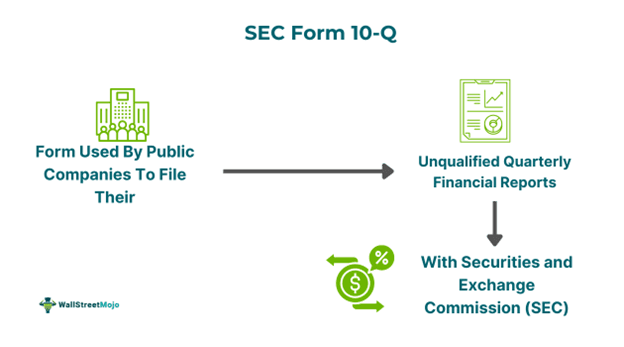Table Of Contents
What Is Form 10-Q?
Form 10-Q is a comprehensive report on the company’s quarterly performance, which is required by the United States Securities & Exchange Commission (SEC) and consists of unaudited financial statements that provide an overview of the company’s financial situation.

10-Q for each first three quarters in a year is to be submitted by the companies to the SEC within a specified time from the end of the quarter, and the report for the fourth quarter is combined with the information for the full fiscal year, i.e., it is to be submitted on the SEC in Form 10-K. Therefore, no 10-Q SEC filing is required in the fourth quarter as after this quarter; the annual form 10-K is filed.
Form 10-Q Explained
Form 10-Q is an unaudited report submitted to the SEC in which firms have to disclose their relevant information for their financial position. It provides investors with information about the financial position of the companies on an ongoing basis.
The filing for each first three quarters in a year is to be submitted by the companies to the SEC within a specified time from the end of the quarter.
The report for the fourth quarter is combined with a report for the full fiscal year, i.e., it is to be submitted on the SEC Form 10-K. This is because federal securities laws made it mandatory for publicly-traded companies to provide some information to the company’s shareholders and the general public.
It discloses the company’s unaudited financial statements and gives an overview of the company’s financial situation. This form is available on the EDGAR database of the SEC.
There are three categories of fillers in which they are classified, which determine the different deadlines to which the company under consideration belongs. This category is known as the company’s public float, where a public float represents a portion of the corporate shares in the hands of the public and that are not held by the officers, owners, or government. All companies require to filing it based on the Form 10-Q instructions and within 40 or 45 days, depending on the size of the public float after the end of the quarter.
The report in Form 10-K, unlike 10-Q, is an audited one that is filed annually. The deadline for filing the 10-Q depends on the company's available float.
Template
The Form 10-Q checklist comprises two parts:
First Part
The first part contains the relevant financial information of the company covering the period, which includes the financial statements in condensed form, discussions of the management, and an analysis of the company's financial condition.
Second part
The second part contains all other pertinent information, including information on the legal proceedings during the period, unregistered sales of the equity securities, use of its proceeds, etc.
Example
Let us consider the following example to understand the Form 10-Q meaning more clearly:
Company XYZ ltd is a publicly-traded company in the US. Accordingly, XYZ ltd has to submit Form 10-Q to the SEC, including details of the discussion of the management and the analysis of the company's financial statements, unaudited quarterly financial information, the notes to financial statements, and all other types of pertinent information as required.
Advantages
- The Form 10-Q is filled to disclose the company's unaudited financial statements and give an overview of the company's financial situation, which provides a window into the company's financial health. Investors can use this information form to see the changes taking place in the company before even the company files the quarterly earnings. Some of the areas in which the investors are generally interested include factors affecting the company's inventory, changes in the working capital account, changes in accounts receivables account, share buybacks, and other information on the company.
- Investors can also use the 10-Q to compare the companies they have invested in or want to invest in the future to see how they are performing. It can give an idea to the investors about whether their choice is correct or not, and further decisions can be taken accordingly.
Disadvantages
- All publicly traded companies are required to file Form 10-Q on a timely basis. Suppose the company fails to submit the same on time and within the extended time allowed by the SEC.
- In that case, it will result in consequences, which include the potential loss of registration with the SEC, removal of the company from the exchanges, and legal ramifications.

